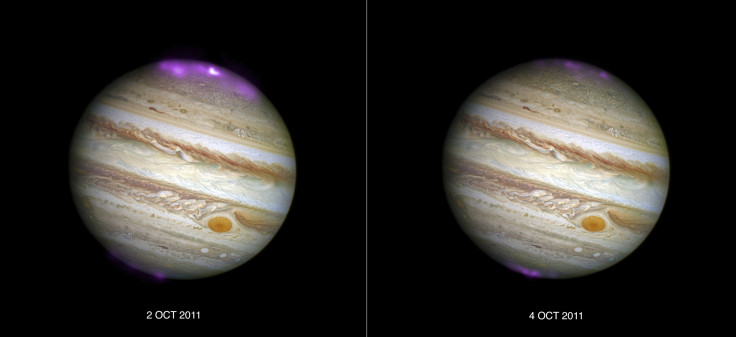Jupiter’s X-Ray Auroras Pulse Independently Of Each Other On Its Poles

The auroras borealis and australis on Earth, or the northern and southern lights, largely mirror each other’s activity and a change in one is matched by simultaneous changes in the other. But that is not the case on Jupiter where the massive and intense auroras of the gas giant pulse independently of each other.
Using data from the European Space Agency’s XMM-Newton and NASA’s Chandra X-ray observatories, scientists realized that the aurora on the Jovian south pole pulse regularly, every 11 minutes while those at Jupiter’s north pole behaved erratically, brightening and diminishing completely independently of their south pole counterparts. Data from these observatories were needed because Jupiter’s auroras are emitted in X-ray.
“We didn’t expect to see Jupiter’s X-ray hot spots pulsing independently as we thought their actions would be coordinated through the planet’s magnetic field. We need to study this further to develop ideas for how Jupiter produces its X-ray aurora and NASA’s Juno mission is really important for this,” William Dunn from University College London (UCL) and the Harvard-Smithsonian Center for Astrophysics, who was lead author of a new study on the subject, said in a statement Monday.
Since the formation of auroras on Earth is linked to the interaction of solar wind and the planet’s magnetic field — which is more or less symmetrical on both hemispheres — the auroras on both the poles mirror each other too. However, in the case of Jupiter, charged particles released due to the volcanic activity on its moon Io also have a role to play. How exactly that affects the formation of X-ray auroras is not yet understood.

And that makes the presence of Juno around Jupiter important, even though the spacecraft doesn’t have any X-ray instruments. Researchers will need to combine data from Juno with observations from XMM-Newton and Chandra.
“If we can start to connect the X-ray signatures with the physical processes that produce them, then we can use those signatures to understand other bodies across the universe such as brown dwarfs, exoplanets or maybe even neutron stars. It is a very powerful and important step towards understanding X-rays throughout the universe and one that we only have while Juno is conducting measurements simultaneously with Chandra and XMM-Newton,” Dunn explained in the statement.
The X-ray hotspots on Jupiter are each larger than the entire surface area of Earth. Dunn and his co-authors think the magnetic field lines on Jupiter vibrate, creating waves of charged particles that travel toward the Jovian poles. They change in speed and direction till such time as they collide with the planet’s thick atmosphere, producing the X-ray aurora. Jupiter is unique among the four large planets in the solar system in having X-ray aurora.
“What I find particularly captivating in these observations, especially at the time when Juno is making measurements in situ, is the fact that we are able to see both of Jupiter’s poles at once, a rare opportunity that last occurred ten years ago. Comparing the behaviors at the two poles allows us to learn much more of the complex magnetic interactions going on in the planet’s environment,” Graziella Branduardi-Raymont of UCL said in the statement.
Titled “The independent pulsations of Jupiter's northern and southern X-ray auroras,” the paper appeared online Monday in the journal Nature Astronomy.
© Copyright IBTimes 2025. All rights reserved.





















